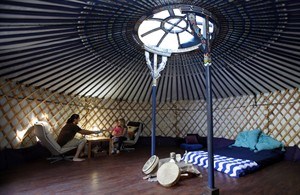
Rebecca Christofferson with daughter Raven, 5, and husband Trevor Husband inside their yurt, a circular portable bent dwelling structure traditionally used in Central Asia by nomads for over 3,000 years. Built in Mongolia and shipped to the Cowichan Valley area, it's used as a healing centre. THE CANADIAN PRESS/Chad Hipolito
July 04, 2013 - 7:00 AM
VICTORIA - Energy-efficient homes have become the norm and in the pursuit of sustainability home owners and designers are returning to a more traditional type, the round home.
But what many residents of circular houses have found is there are also spiritual and emotional benefits to the shape.
Rebecca Christofferson, clinical counsellor and art therapist, lives in Vancouver Island's Cowichan Valley and had intended on building a round cob home on her property. But when she realized there was an existing home on the lot she decided to erect a yurt to serve as a guest bedroom, workshop and spiritual healing space.
"A big part of why I decided to build a yurt was the circular space," said Christofferson. "The imagery of the nomadic was significant as well, and you don't need to have it permitted so there is a real freedom with that."
Yurts are portable homes traditionally used by nomads in Central Asia made of wooden ribs and layers of fabric and sheep's wool felt for insulation and weatherproofing.
"People who have spent time in our yurt have said the world sort of shuts out," said Christofferson. "It just feels like a huge blanket on the space; it is womb-like. The world slows down and it is energetically quieter."
While some people have chosen yurts for their temporary qualities, designers like Lars Chose have channelled the spiritual qualities he's identified in round homes into the structures he creates with his company Mandala Custom Homes.
Chose had been designing and building homes for 20 years on the side while working as a psychotherapist, but it wasn't until 1995 that he built his first round house.
"I saw where the world was going with the environment and the work I was doing with children and families," he said. "It came to me one day that I needed to be part of the change that needed to happen in a much stronger way.
"I had been studying how homes take half our resources to build and half our resources to cool and keep warm, and I decided to start a company and use the round (shape) as a way to express both an environmentally friendly and a healthy home."
As a practising Buddhist, Chose said the shape connected well with the word mandala which has significance to the religion.
According to Chose, mandala means the interconnected whole.
"For me the most awakened place is when we live in that awakened (sense of) knowing that we are interdependent," he said.
"There is no separation and that is our greatest pain to feel that separation. To be in a building that is shaking you and communicating that interdependence it just supports and amplifies any spiritual practice or yearnings that we have."
Even though the round spaces created by yurts and designers like Chose create various spiritual connections, other companies like North Carolina's Deltec Homes got into circular construction for more practical reasons.
The Asheville company began in 1968 supplying buildings to the resort industry.
Joseph Schlenk, director of marketing and sales, said their clients were coming to them wanting a structure that could be durable, energy efficient, easy to build and take advantage of outstanding views.
"The original Deltec structure was an A-frame," said Schlenk. "We learned very quickly that was not energy efficient or durable, and in that same year we developed the polygonal structure, the predecessor to the Deltec structure today."
Deltec — which now ships hundreds of homes throughout Canada including Baffin Island — has seen a complete shift in their clientele, from 100 per cent in the resort industry to 95 per cent residential.
"We have a long history of success as far as durability," said Schlenk. "We have never lost a home because of high winds. The same qualities that make them resistant to high winds also make them very energy efficient.
"They are aerodynamic. There are not any great significant areas of flat surface where air or wind can build up pressure. It flows around the building so there is very little threat to drafting."
News from © The Canadian Press, 2013